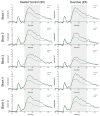Effects of Low-Intensity Aerobic Exercise on Neurophysiological and Behavioral Correlates of Cognitive Function
- PMID: 37232638
- PMCID: PMC10215816
- DOI: 10.3390/bs13050401
Effects of Low-Intensity Aerobic Exercise on Neurophysiological and Behavioral Correlates of Cognitive Function
Abstract
Acute aerobic exercise exerts a small beneficial effect on cognition. Previous research primarily examines cognitive changes following a bout of exercise, while little is currently known about changes in cognitive performance during exercise. The primary purpose of this study was to examine the effects of low-intensity cycling on cognitive function indexed by behavioral (response accuracy; reaction time) and neurocognitive (P3 mean amplitude; P3 centroid latency) responses. Twenty-seven (Mage = 22.9 ± 3.0 years old) individuals were counterbalanced into low-intensity exercise (EX) and seated control (SC) conditions spread across two testing sessions. During each condition, participants completed a 10 min resting baseline period, 20 min of either sustained cycling or seated rest, and a 20 min recovery period. Primary outcomes were assessed at 10 min intervals (five blocks total) throughout each condition via a modified visual oddball task while electroencephalography (EEG) responses were measured. Across time blocks, both conditions exhibited faster reaction times on frequent trials but reduced accuracy to rare trials, suggesting a speed-accuracy tradeoff. There were no differences between conditions in P3 centroid latency, whereas a significant reduction in P3 amplitude was observed during the 20 min exercise period compared to the control condition. Taken together, results suggest that exercise at lower doses may have minimal influence on behavioral outcomes of cognitive performance but may impact more basic measures of brain function. Information gathered from this study may aid in the development of appropriate exercise prescriptions for populations looking to specifically target cognitive function deficits.
Keywords: EEG; ERP; P3; aerobic exercise; cognitive function.
Conflict of interest statement
The authors declare no conflict of interest.
Figures





References
-
- Sibley B.A., Etnier J.L. The relationship between physical activity and cognition in children: A meta-analysis. Pediatr. Exerc. Sci. 2003;15:243–256. doi: 10.1123/pes.15.3.243. - DOI
LinkOut - more resources
Full Text Sources

